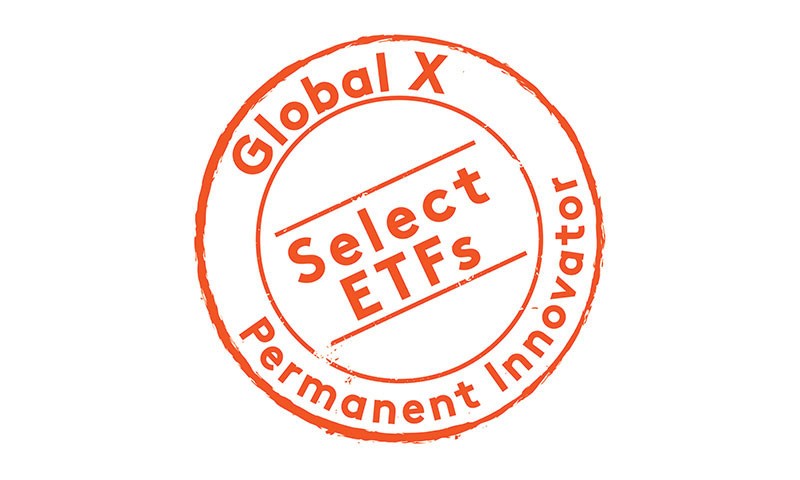Important Information
Investors should not base investment decisions on this website alone. Please refer to the Prospectus for details including the product features and the risk factors. Investment involves risks. There is no guarantee of the repayment of the principal. Investors should note:
- Global X China Biotech ETF’s (the “Fund’s”) investment in equity securities is subject to general market risks, whose value may fluctuate due to various factors, such as changes in investment sentiment, political and economic conditions and issuer-specific factors.
- Biotech companies invest heavily in research and development which may not necessarily lead to commercially successful products, and the ability for biotech companies to obtain regulatory approval (for example, product approval) may be long and costly.
- China is an emerging market. The Fund invests in Chinese companies which may involve increased risks and special considerations not typically associated with investments in more developed markets, such as liquidity risk, currency risks, political risk, legal and taxation risks, and the likelihood of a high degree of volatility.
- The trading price of the Fund’s unit (the “Unit”) on the Stock Exchange of Hong Kong is driven by market factors such as demand and supply of the Unit. Therefore, the Units may trade at a substantial premium or discount to the Fund’s net asset value.
- The Fund’s synthetic replication strategy will involve investing up to 50% of its net asset value in financial derivative instruments (“FDIs”), mainly funded total return swap transaction(s) through one or more counterparty(ies). Risks associated with FDIs include counterparty/credit risk, liquidity risk, valuation risk, volatility risk and over-the-counter transaction risk. FDIs are susceptible to price fluctuations and higher volatility, and may have large bid and offer spreads and no active secondary markets. The leverage element/component of an FDI can result in a loss significantly greater than the amount invested in the FDI by the Sub-Fund.
- As part of the securities lending transactions, there is a risk of shortfall of collateral value due to inaccurate pricing of the securities lent or change of value of securities lent. This may cause significant losses to the Fund. The borrower may fail to return the securities in a timely manner or at all. The Fund may suffer from a loss or delay when recovering the securities lent out. This may restrict the Fund’s ability in meeting delivery or payment obligations from realisation requests.
- Global X China MedTech ETF’s (the “Fund’s”) objective is to provide investment results that, before fees and expenses, closely correspond to the performance of the Solactive China MedTech Index (the “Index”).
- The Index is a new index. The Index has minimal operating history by which investors can evaluate its previous performance. There can be no assurance as to the performance of the Index. The Fund may be riskier than other exchange traded funds tracking more established indices with longer operating history.
- The Fund may invest in small and/or mid-capitalisation companies. The stock of small-capitalisation and mid-capitalisation companies may have lower liquidity and their prices are more volatile to adverse economic developments than those of larger capitalisation companies in general.
- The Fund’s investments are concentrated in companies in the medical technology industry. The value of the Fund may be more volatile than that of a fund having a more diverse portfolio of investments and may be more susceptible to adverse economic, political, policy, liquidity, tax, legal or regulatory event affecting the relevant industry.
- Many of the companies with a high business exposure to a medical technology theme have a relatively short operating history. Rapid changes could render obsolete the products and services offered by these companies and cause severe or complete declines in the prices of the securities of those companies. Additionally, companies with medical technology themes may face dramatic and often unpredictable changes in growth rates and competition for the services of qualified personnel. They may potentially subject to (i) substantial government intervention in the technology industry (including restrictions on investment in internet and technology companies), (ii) complex laws and regulations including privacy, data protection, content regulation, intellectual property, competition, protection of minors, consumer protection and taxation, (iii) heavy and significant capital investment on research and development, (iv) risks of medical failure (including injury or death of patients), negligence or product liability claims, recall or withdrawal of products. These risks may result in adverse impact of the operating results of the companies.
- The Mainland China is an emerging market. The Fund invests in Mainland Chinese companies which may involve increased risks and special considerations not typically associated with investment in more developed markets, such as liquidity risk, currency risks or control, political and economic uncertainties, legal and taxation risks, settlement risks, custody risk and the likelihood of a high degree of volatility. Securities exchanges in the Mainland Chinese markets typically have the right to suspend or limit trading in any security traded on the relevant exchange. The government or the regulators may also implement policies that may affect the financial markets. All these may have a negative impact on the Fund.
- Listed companies on the ChiNext market and/or STAR Board are subject to higher fluctuation on stock prices and liquidity risk, over-valuation risk, less stringent regulation risk, delisting risk and concentration risk.
- The Fund’s synthetic replication strategy will involve investing up to 50% of its net asset value in financial derivative instruments (“FDIs”), mainly funded total return swap transaction(s) through one or more counterparty(ies). Risks associated with FDIs include counterparty/credit risk, liquidity risk, valuation risk, volatility risk and over-the-counter transaction risk. FDIs are susceptible to price fluctuations and higher volatility, and may have large bid and offer spreads and no active secondary markets. The leverage element/component of an FDI can result in a loss significantly greater than the amount invested in the FDI by the Fund.
- As part of the securities lending transactions, there is a risk of shortfall of collateral value due to inaccurate pricing of the securities lent or change of value of securities lent. This may cause significant losses to the Fund. The borrower may fail to return the securities in a timely manner or at all. The Fund may suffer from a loss or delay when recovering the securities lent out. This may restrict the Fund’s ability in meeting delivery or payment obligations from redemption requests.
- The trading price of the Shares on the Stock Exchange of Hong Kong is driven by market factors such as the demand and supply of the Shares. Therefore, the Shares may trade at a substantial premium or discount to the Fund’s Net Asset Value.
- Payments of distributions out of capital or effectively out of capital amounts to a return or withdrawal of part of an investor’s original investment or from any capital gains attributable to that original investment. Any such distributions may result in an immediate reduction in the Net Asset Value per Share of the Fund and will reduce the capital available for future investment.
China Biotech and MedTech Experienced Sector-wise Rally
China Biotech and Medtech sector delivered a decent rally today, with Global X China Biotech ETF and Global X China Medtech ETF up 4% and 2% respectively.
| Global X ETF Performance | 1D | 1M | 3M | 6M | YTD |
|---|---|---|---|---|---|
| Global X China Biotech ETF (2820 HK) (Please click here Link to view the full performance of the fund.) |
4% | -4% | 12% | 1% | -14% |
| Global X China Medtech ETF (2841 HK) (Please click here Link to view the full performance of the fund.) |
2% | 0% | 21% | -1% | -11% |
Source: Bloomberg, data as of 20 Nov 2024.
We believe this positive momentum is mainly driven by supportive news and growing expectations for stimulus policies:
1) A news headline highlighted the potentially increasing cooperation between commercial insurance and medical insurance.
2) On Nov 18, the “2024 Medical Devices Economic Information Release Conference” hosted by National Medical Products Administration (NMPA) was held in Shanghai. The conference emphasized the necessity of deepening reforms of comprehensive life cycle supervision of medical devices. It called for an accelerated cultivation and development of new, high-quality medical device production to better address public’s health needs.
3) On Nov 11, National Healthcare Security Administration and Ministry of Finance issued a Notice on improving prepayment system of medical insurance funds at the national level, which is expected to effectively alleviate the triangular debt issues in the pharmaceutical sector and speed up the capital turnover of pharmaceutical companies.
4) Market expectations for stimulus policies are rising, following the meetings of China’s State Medical Insurance Bureau. On Nov 12, the Bureau summoned leading pharmaceutical and medical device companies for discussions, and on November 18, it brought together capital market experts to exchange ideas. Key points discussed during these meetings included: i) Fiscal spending will ensure over 10% medical insurance spending growth each year; ii) Commercial insurance accounts for 10% of China’s total medical spending, and related policies will be announced in late Nov to better use commercial insurance; iii) VBP will be centrally managed; iv) Continue supporting Innovative drugs. However, it is important to note that no specific figures have been disclosed or confirmed by regulators thus far.
The sector has been under pressure in the past month upon market-wise correction. Additionally, we have observed improving fundamentals, as the number of innovative drugs’ IND and NDA applications has rebounded after hitting a low point in 2022. In 3Q24, there were 1,033 drug clinical approvals, representing 25% YoY growth. A total of 8 first-class innovative drugs were approved for marketing, doubling compared to the same period last year.
| Global X China Biotech ETF (2820 HKD) |
Global X China MedTech ETF (2841 HKD) |
|
|---|---|---|
| Inception Date | 24 Jul 2019 | 03 Aug 2023 |
| Reference Index | Solactive China Biotech Index | Solactive China MedTech Index |
| Primary Exchange | Hong Kong Stock Exchange | Hong Kong Stock Exchange |
| Total Expense Ratio | 0.68% p.a. | 0.68% p.a. |
| Product Page | Link | Link |
Source: Mirae Asset; Data as of November 2024.



